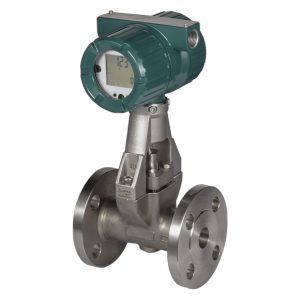Vortex flowmeters - VY series
Vortex VY Series flowmeters are highly versatile and can measure the flow of liquids, gases and vapour over a wide pressure and temperature range.
Flexible process connections
The VY series offers several mounting options:
-
Wafer or flange connection
-
Pipe sizes from DN15 to DN400
-
Pressure classes up to PN100
Withstands extreme temperatures
The meter works reliably at both low and high temperatures:
-
From -196 °C up to +450 °C
-
Suitable for both small and large flows
Advantages of the VY series
-
Large measuring range (rangeability 80:1)
High accuracy even with large variations in flow rate. -
Low pressure loss
Lower pressure drop compared to traditional orifice gauges. -
Robust and maintenance-free design
No moving parts in the sensor means minimal maintenance.
Typical uses
-
Steam: Suitable for both saturated and superheated steam
-
gas: For example, hydrogen, nitrogen and air
-
Liquids: Both conductive and non-conductive liquids, e.g. LNG, cryogenic liquids and chemicals
Technology and features
-
In-built self-diagnostics
Make it easy to troubleshoot and perform remote maintenance -
Digital signal processing
Eliminates interference from pipe vibrations and provides stable measurement
Total Insight concept
-
Simplified product selection
Reduces the need for technical preparation and lowers purchasing costs -
Smart installation assistance
Shortens start-up time and simplifies commissioning
Working principle behind vortex flowmeters
The basic principle is that when liquid or gas flows past the blunt obstacle, pressure variations or movements occur in the flow of the medium. The frequency of these pressure variations is directly related to the speed of the flow. In a vortex flowmeter, there is usually a sensor (for example, a piezoelectric transducer) that records these vortex frequencies. By measuring how often the vortices occur, the meter can calculate the flow rate and thus the flow (volume flow).
Here is a simplified summary of how it works:
-
Bluff body: The meter has a small rod or body that sticks into the flow path.
-
Swirl formation: As the flow passes this body, vortices form at the back of the body. These vortices are released alternately on the right and left sides, creating regular pulses.
-
Sensor sensing: A transducer (e.g. piezoelectric or ultrasonic) records changes in pressure or velocity caused by the vortices.
-
Frequency and speed: The number of vortices per unit time (frequency) is proportional to the flow rate.
-
Calculation of flow: By knowing the geometry of the meter and the relationship between swirl frequency and flow rate (called Strouhal number), the instrument can calculate the actual flow.
The benefits of vortex flowmeters
Advantages of vortex flowmeters include the fact that they have no moving parts to wear out (compared to many mechanical flowmeters) and that they can be used for a range of media, including gases, vapours and liquids. However, it is important to recognise that they require a certain amount of straightness before and after the measuring point to avoid disturbing the vortex formation, and that they are not always suitable for very low flow rates or for high viscosity media.

